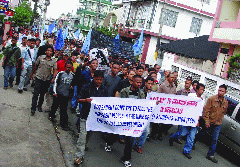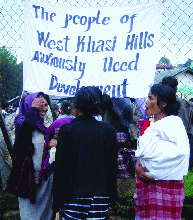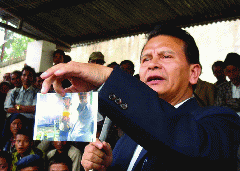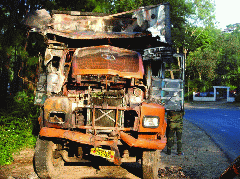Archives
The Epicentre of Uranium Rumblings
 There is also ample availability of water resources for the setting up of micro and mini hydel projects that can be run and sustained by the people themselves. All these put together can meet the electricity requirements without any air or ground pollution and without emitting any global warming gasses and most importantly, no radioactive waste. In fact, power can be generated even from a tree. These, therefore, are challenges in which the power sector can be effectively addressed.
There is also ample availability of water resources for the setting up of micro and mini hydel projects that can be run and sustained by the people themselves. All these put together can meet the electricity requirements without any air or ground pollution and without emitting any global warming gasses and most importantly, no radioactive waste. In fact, power can be generated even from a tree. These, therefore, are challenges in which the power sector can be effectively addressed.
The question therefore is, why is there this craze for nuclear energy which is the root cause of fear of terminal diseases, unsettling of populated settlements and poisoning of the environment which is causing a lot of worry of rising global temperatures, rising sea levels and melting ice caps and receding glaciers in different parts of the world.
It is therefore in this context that various doubts have arisen as to what would be the consequences of the mining of uranium in a state whose area is only 22,429 square kilometres and having a population of just about 23,06,069, a state which, throughout the years, has been scarred by the wanton felling of trees and indiscriminate mining of minerals like coal and limestone which has caused not only environmental damage but has also brought about social ills and has unsettled the demographic structure.
For the last twenty years or so since the discovery of uranium deposits in the state, the government, till today, has failed to come out with a factual statement on the status of mining the mineral. What exactly is uranium is a question whose answer many people of the state have the least idea of. Even the Uranium Corporation of India (UCIL) has not given any clear and detailed information on how uranium would be mined, what would be the effects of such mining on the people, animals and the environment and whether the mining will be in the style that is currently being utilised in Jharkand’s Jaduguda area.
out with a factual statement on the status of mining the mineral. What exactly is uranium is a question whose answer many people of the state have the least idea of. Even the Uranium Corporation of India (UCIL) has not given any clear and detailed information on how uranium would be mined, what would be the effects of such mining on the people, animals and the environment and whether the mining will be in the style that is currently being utilised in Jharkand’s Jaduguda area.
Instead, the government had diverted the whole issue by signing a memorandum of understanding with UCIL for a rupees two hundred and nine crore project to develop the areas having reserves of uranium in the West Khasi Hills district of Meghalaya. This has aroused a lot of controversy which has added fuel to the protests against the move and which is causing political uncertainty and confusion. Though the government has claimed that a cabinet decision was taken on the signing of the MOU, the leader of the Hills State Peoples Party Mr. Hopingstone Lyngdoh, being part of the Meghalaya United Alliance, has disclaimed that he was part of the decision. The United Democratic Party being a major partner of the government has clarified that it was only extending conditional support to the government on the uranium issue. Above all, the people of the state are being left in the dark on the terms and conditions of the MOU.
In the meantime, the state is witnessing rallies and agitations including road blockades leading to the torching of some government offices and vehicles in the districts of West Khasi Hills, East Khasi Hills, Ri Bhoi and Jaintia Hills of East Meghalaya. Interestingly, about fifty members of the Co – ordination Committee of social organisations had managed to enter the premises of  the State Secretariat during its working hours and had pinned black flags on the ministers and government staff as a mark of opposition to the government’s attitude on the issue of uranium including the MOU signed with UCIL.
the State Secretariat during its working hours and had pinned black flags on the ministers and government staff as a mark of opposition to the government’s attitude on the issue of uranium including the MOU signed with UCIL.
The government had however suffered a major set back when some journalists of Shillong visited Jaduguda and splashed details of their fact finding mission on both print and electronic media. The details included the manner in which uranium is being mined, its effects on the miners, their families and the people of the surrounding villages, especially on health related matters. The press reports were so startling and candid that they brought about adverse reactions in a cross section of the society; right from the elite in the state capital Shillong and this spilled over to the common people in rural areas.
The Deputy Chief Minister Dr. Mukul Sangma said that the government had planned an aggressive campaign to enlighten the people on the issue of mining through seminars, workshops and discussions which had never come to light. His tail piece being, “Even the government wants to know more about the issue.”
The negative aspects of uranium have now gone global, as seen through the internet. The people nearest to the epicenter of the  uranium rumblings, the MLAs, MDCs, traditional heads like Syiems (kings) and Lyngdohs (ministers), academic and public leaders, meeting at Nongstoin, the headquarters of West Khasi Hills had failed to come to any conclusion on the evasive issue of uranium.
uranium rumblings, the MLAs, MDCs, traditional heads like Syiems (kings) and Lyngdohs (ministers), academic and public leaders, meeting at Nongstoin, the headquarters of West Khasi Hills had failed to come to any conclusion on the evasive issue of uranium.
The legislator from Nongkrem Ardent Basaiawmoit who belongs to the UDP, a partner of the MUA government has started a political movement against uranium in the length and breadth of the Khasi Jaintia Hills known as Ri Hynniewtrep and Ms. Fenella L. Nonglait, Vice Chairperson of the State Law Commission and one of the leaders of the Meghalaya Legal Aid Forum has threatened to file a Public Interest Litigation (PIL) against uranium mining. The National Federation of Youth Organisations in neighbouring Bangladesh has, in a rally, proclaimed, “No to uranium mining in Meghalaya.”
 A little known about fact which is very apt here is that, 65 million years ago, in what is Meghalaya today, dinosaurs had walked the land in the West Khasi Hills region. This is according to the findings of paleontologists of the Geological Survey of India. The pertinent question asked here is how the Jurassic creatures in the West Khasi Hills perished during the Cretaceous period. According to senior paleontologists of the GSI, the extinction of the dinosaurs could well have been due to uranium radiation. Traces of uranium had been found in the bones of these dinosaurs recovered from Ranikor in West Khasi Hills which could have been a reason for their extinction.
A little known about fact which is very apt here is that, 65 million years ago, in what is Meghalaya today, dinosaurs had walked the land in the West Khasi Hills region. This is according to the findings of paleontologists of the Geological Survey of India. The pertinent question asked here is how the Jurassic creatures in the West Khasi Hills perished during the Cretaceous period. According to senior paleontologists of the GSI, the extinction of the dinosaurs could well have been due to uranium radiation. Traces of uranium had been found in the bones of these dinosaurs recovered from Ranikor in West Khasi Hills which could have been a reason for their extinction.
Sumar Sing Sawian

